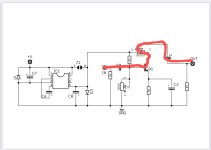So I have built this rangemaster (done loads of these) with a NPN transistor. It WAS working. The person who I did for says there is no sound on engaging the pedal (works in bypass and led is good.)
My thoughts are to get in there with an audio probe to work out what has gone wrong (after visual checks etc.) Here is the issue, I just can’t get my head around how to follow a schematic. I know I start at the ‘in’ of the jack and then the board but where the hell do I go then. Thank god it’s only a handful of components. There is no D3, IC, C6 or C8 in this build.
If anyone could help with a road map I would appreciate it.

My thoughts are to get in there with an audio probe to work out what has gone wrong (after visual checks etc.) Here is the issue, I just can’t get my head around how to follow a schematic. I know I start at the ‘in’ of the jack and then the board but where the hell do I go then. Thank god it’s only a handful of components. There is no D3, IC, C6 or C8 in this build.
If anyone could help with a road map I would appreciate it.




